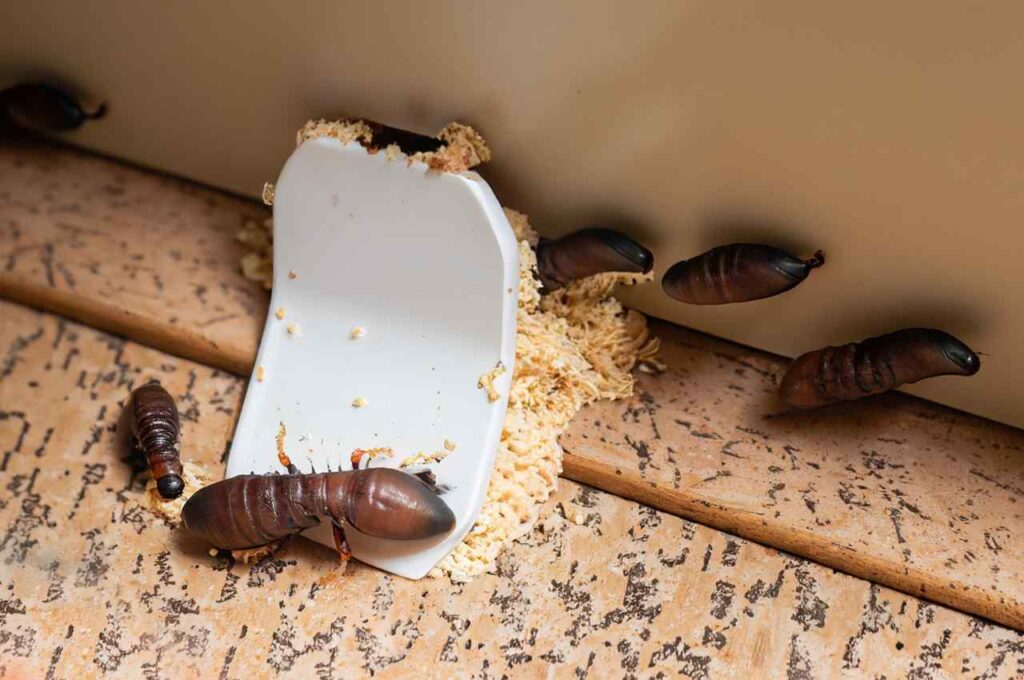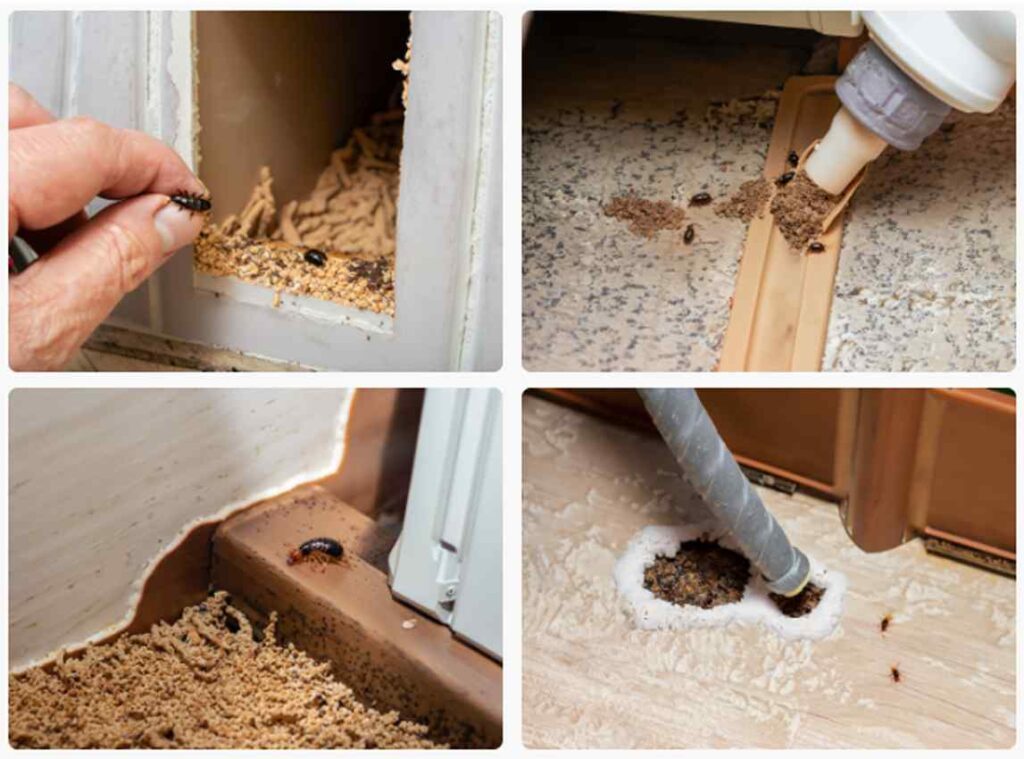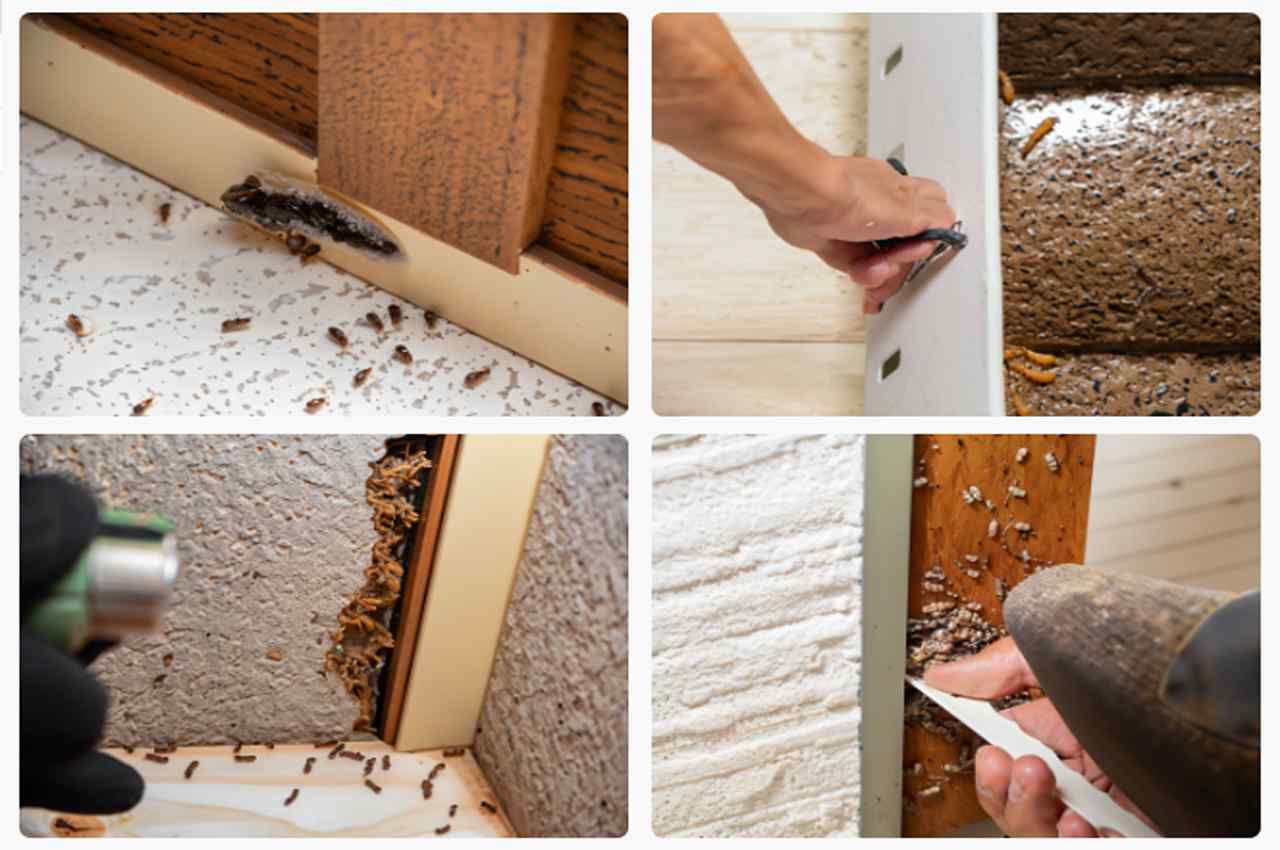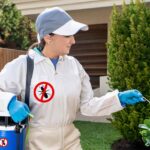Want to know How to treat house for termites and take action against termites. Welcome to our thorough information on termite treatment for your home! If left uncontrolled, termites, or “silent destroyers,” may wreck your property. These small but powerful insects devour wood and may cause costly structural damage. With awareness and preventative actions, you can protect your house against termites and retain its integrity. This article will teach you how to treat your home for termites for peace of mind and long-term property protection. You may learn how to control termites as a homeowner or with an existing infestation.
How to treat house for termites?
The two major methods for treating a home with termites are:
- Professional treatment: This eliminates termites most successfully. The soil around your house and any affected timber will be treated using specialized tools and chemicals by a professional pest control business.
- DIY treatment: While certain DIY techniques for eliminating termites may be successful, they are not as dependable as professional treatment. Typical DIY techniques include:
- Spraying termiticides on the ground surrounding your property with liquid or foam.
- Installing bait stations for termites.
- Boric acid is sprayed all over the damaged regions.
It’s crucial to carefully read the instructions and apply the right materials if you decide to treat your property for termites yourself. Additionally, you need to be aware that not all DIY remedies will work.

Here are some more suggestions for avoiding termites:
- Maintain a dry house. Make sure there are no leaks in your plumbing or near your foundation since termites need moisture to live.
- Repair any foundational or external holes or cracks in your house. These gaps are entry points for termites inside your house.
- Grow bushes and trees far from your house. Termites may enter your house via the roots of trees and bushes.
- Routinely check your house for termite damage. Contact a pest treatment provider right away if you see any termite indicators, such as mud tubes or frass.
The following are some of the best termite killers:

| Termite Treatment Method | Description |
|---|---|
| 1. Spraying Termiticides on the Ground (Surrounding Your Property) | · Involves applying termiticides in the form of liquid or foam around the outside of your home. |
| · Serves as a chemical barrier to keep termites away from your house. | |
| 2. Installing Bait Stations for Termites | · Frequently used for termite prevention, with the potential for reapplication on occasion. |
| · Involves placing bait stations in key spots across your property. | |
| · These stations include termite bait, which attracts termites and kills them. | |
| · A technique that is often utilized for both termite prevention and current infestations. | |
| 3. Boric Acid Treatment | · Needs to be monitored and maintained by pest control experts. |
| · Involves spraying areas where termite activity has been found with boric acid, usually in powder form. | |
| · Termites are poisoned by boric acid, which may also interfere with their digestive processes and cause them to die. | |
| · Frequently used as a targeted treatment for limited termite damage. |
The kind of termites you have and the intensity of the infestation will determine the best termite killer for your house. It is always preferable to speak with a pest control expert to acquire the greatest guidance for your particular circumstance.
What are the signs of termite damage in a house?
The following are some of the most common signs of termite damage to a home:
| Common Signs of Termite Damage in a House | Description |
|---|---|
| 1. Mud Tubes | Termites generally create mud tubes on foundations, walls, or other surfaces to get from the earth to food sources. |
| 2. Frass (Termite Excrement) | A thin, powdery substance called termite frass is seen around mud tubes or in places where termites have been active. |
| 3. Hollow Wood | Since termites eat away at the wood's interior structure, infested wood often sounds hollow when tapped. |
| 4. Sagging Floors or Ceilings | Termites may compromise a house's structural stability, causing the floors or ceilings to droop. |
| 5. Winged Termites (Swarmers) | A termite swarm, or winged termites, is a symptom of an active infestation in or around your house. |
| 6. Damaged Drywall | Drywall may become bubbled, cracked, or peeled as a result of termite damage. |
| 7. Loose Tiles | Termite damage to tiles may cause them to loosen or fall off of walls or floors. |
| 8. Musty Odor | A musty smell that you might detect in your house could be a sign that termites have caused damage. |
What are the common termite treatment options available?
There are a number of popular termite treatment treatments available, each having pros and cons.
The most typical termite treatment method is soil treatment. The soil around your home’s foundation is treated with a liquid or foam termiticide to create a barrier that keeps termites out. Although it might be costly and disruptive, soil treatment is effective against the majority of termite species.
- Bait system: A more recent innovation is a termite bait system. Termites are attracted to the food supply in bait stations, which are positioned around your house. The poison that the termites consume when they devour the meal kills them. Although they sometimes take longer to operate than other approaches, bait systems are efficient against subterranean termites.
- Fumigation is the most costly and disruptive termite treatment, but it is also one of the most effective. Your house is sealed off and filled with a deadly gas that kills termites throughout the fumigation process. Only the most severe termite infestations need fumigation.
- Wood treatment: Wood treatment is a technique for termite protection. Termites cannot consume the wood because of a chemical treatment applied to it. Drywood termites can be controlled with wood treatment, while subterranean termites cannot be controlled.
- Combination therapy: A variety of therapy approaches may be employed in certain circumstances. To give a more all-encompassing strategy to termite management, for instance, a soil treatment and a bait system may be used together.
The level of infestation, the kind of termites you have, and your budget will all affect the best termite treatment choice for your house.
How much does it cost to treat a house for termites?
The size of your property, the extent of the infestation, the kind of treatment employed, and the location of your home are just a few of the variables that might affect the price of termite treatment.
The average price of termite treatment varies from $229 to $962, according to HomeAdvisor. However, in other circumstances, such as when the infestation is severe or the treatment necessitates fumigation, the cost may be greater.
The average cost of each form of termite treatment is broken out below:
| Type of Termite Treatment | Average Cost Range |
|---|---|
| Soil Treatment | $229 to $439 |
| Bait System | $349 to $659 |
| Termite Fumigation | $1,200 to $3,000 |
| Wood Treatment | $300 to $500 |
| Combination Treatment | $400 to $1,000 |
*Note that these are an estimated cost and actual cost may depend on several factors.
Is it possible to prevent termite infestations in the first place?
Certainly! Fix leaks and moisture to keep your property dry and avoid termite infestations. Termites may also be prevented by sealing foundation and external cracks and holes. Planting trees and bushes far from your home prevents termites from utilizing their roots as passageways. Termite damage, such as mud tubes or frass, must be inspected regularly and treated by a pest control professional immediately. Consider a termite prevention strategy, which frequently includes expert treatments and regular inspections, to keep termites away. Combining these methods may greatly minimize termite infestations and safeguard your house.
What steps can I take to protect my wooden furniture from termites?
Termites thrive in wet environments, so keep your wooden furniture dry to prevent them. If possible, keep your furnishings out of humid places like kitchens and bathrooms. Applying a termite-resistant coating on wooden furniture helps deter termites. Cedar and redwood naturally repel termites, making them ideal for furniture. Check your furniture for termite damage, such as mud tubes or frass, and call a pest treatment specialist immediately. Storage furniture outside should be dry and sheltered from the weather. Be careful not to damage furniture during transit since termites may enter via little cracks or holes. You can protect your wooden furniture from termites by following these instructions.
Are there any eco-friendly or non-toxic termite treatment solutions?
For natural termite control, there are various eco-friendly or non-toxic options. Termite bait stations kill termites slowly using slow-acting poisons. Boric acid may be sprayed or applied to wood to kill termites. The fossilized diatoms in diatomaceous earth may scratch termites’ exoskeletons. Orange oil, made from orange rinds and contains d-limonene, may kill termites. Environmentally friendly procedures are less hazardous to persons and the environment, but they may be less effective than chemical treatments. They are a good termite control solution for non-toxic or eco-friendly methods.
How long does it typically take to treat termites in a house?
The size of the residence, the infestation, and the treatment technique may all affect how long termite treatment takes. Termite treatment usually takes a few days to weeks. Common soil remediation takes 2–7 days. Bait system treatments last 3–6 months. Termite fumigation is effective but takes 2–5 days. Wood treatment takes 1–3 days. These timeframes are estimates and may vary depending on individual infestation. Consulting a pest control specialist for a more precise quotation is crucial.
Should I hire a professional pest control service for termite treatment, or can I do it myself?
Several criteria determine whether you employ a pest control agency or treat termites yourself. If you’re comfortable, DIY methods using home remedies or over-the-counter pesticides may work for mild infestations. In severe infestations or with particular termite species, professional help is advised. Pest control experts have the skills, equipment, and chemicals to solve termite problems. They may help prevent future infestations, giving you piece of mind. DIY treatments may save money, provide a feeling of achievement, and give family and pet safety more control. However, it’s important to follow instructions and use proper materials since DIY approaches may not be as effective as professional therapy. The choice should depend on your termite issue and confidence in treating it.
Can termites return after treatment, and how can I prevent their recurrence?
If the fundamental reasons and favorable circumstances that attracted termites to your property have not been addressed, they may return after treatment. Fixing foundation and plumbing leaks keeps your house dry and prevents them from returning. Block termite ingress by sealing foundation and external cracks and holes. To prevent termites from utilizing tree and shrub roots as routes, plant them away from your home. Check your house for termite damage like mud tubes and frass and call a pest control specialist immediately. Pest control organizations provide termite protection plans with regular inspections and aggressive ways to resist termites. These methods reduce termite reinfestations and protect your house over time.
Is tenting or fumigation the only effective way to treat a termite infestation?
Tenting or fumigating termites is not the only effective option. There are numerous therapy options for different situations. Soil treatment prevents termites by putting liquid or foam termiticides around your home’s foundation. Attractive bait stations in termite bait systems poison termites when eaten. Preventing termites from eating wood is especially effective against drywood termites. Combining approaches like soil remediation and bait systems may be extensive. Although very efficient, termite fumigation is reserved for serious infestations owing to expense and disturbance. The intensity, termite type, and budget of the infestation determine the best treatment, so visit a pest control specialist for personalized assistance.
What should I do if I suspect termites in my wooden deck or outdoor structures?
Take urgent action if you suspect termites in your hardwood deck or outdoor constructions. Start by thoroughly inspecting the area for termite activity, such as mud tubes, frass, or flying termites. Next, call a termite pest treatment expert. They will evaluate your deck or outdoor buildings, identify termite presence, and offer the best treatment depending on termite type and infestation intensity. Professional treatment may be needed for serious infestations. To prevent re-infestation, monitor the region after treatment. Your outdoor wooden buildings need early notice and quick action to minimize damage.
Are there any natural or organic methods for termite treatment?
For eco-conscious termite control, natural and organic solutions may work. Boric acid may be sprayed or applied to wood to kill termites. Fossilized diatoms in diatomaceous earth erode termite exoskeletons. Orange oil from orange rinds contains d-limonene, a natural termite repellent. Another non-toxic technique is azadirachtin containing neem oil. Pyrethrum in marigolds repels termites, making them a good prophylactic strategy. These natural or organic approaches may not be as successful as chemical treatments, especially for serious infestations. For non-toxic termite management, they are safer and more ecologically friendly.
How do I choose a reputable termite extermination company?
Selecting a reliable termite removal business requires many measures. Start with word-of-mouth recommendations from friends, family, and neighbors for vital insights. You may also check your local Better Business Bureau for corporate complaints. Compare pricing and service estimates from numerous vendors to make an educated selection. Make sure your organization is licensed and insured to cover treatment surprises. Ask about their warranty to protect against termite reinfestations. Finally, write down the estimate, treatment plan, and guarantee or warranty to avoid confusion. This thorough technique can help you choose a trustworthy termite removal provider.
Can I stay in my house during termite treatment, or do I need to vacate?
You may remain in your home during termite treatment, depending on the approach. You may usually stay in your house during soil treatment, which entails administering a termiticide to the soil surrounding your foundation. Bait systems, which use bait stations to attract and poison termites, normally don’t need you to leave, although dogs and children should be kept away. Termite fumigation, the most successful but most costly and disruptive approach, requires a 24-hour evacuation since it seals the house and fills it with deadly fumes. Wood treatment, which repels termites, usually doesn’t need you to leave home. To protect your safety and treatment’s efficacy, follow the pest control specialists’ instructions.
What precautions should I take to protect my pets and plants during termite treatment?
To safeguard your pets and plants during termite treatment, consider the treatment type. Keep dogs inside during termite fumigation since the fumigant gas might hurt them. To avoid contamination, move your plants away from the treatment zone and cover any food or water sources dogs or plants may reach. After treatment, wash pets and plants to eliminate chemicals. Soil treatment, bait systems, and fumigation may require additional precautions like keeping pets and children away from treated areas or vacating the home for at least 24 hours while keeping pets and plants out.
Are there any warranties or guarantees for termite treatments?
Pest control businesses often provide termite treatment warranties and guarantees, depending on the firm and treatment. These include one-year guarantees that cover retreatment expenses if termites return during the first year, three-year warranties with extended coverage, and lifetime warranties that last as long as you own your property. Carefully evaluate any warranty’s terms and conditions, including cost, coverage, and the pest control company’s reputation. Ensure the warranty is transferrable if you sell your house to preserve your termite treatment investment.
Is it possible to negotiate the cost of termite treatment with pest control companies?
It is feasible to negotiate termite treatment costs with pest control firms. To bargain effectively, get many quotes to determine the treatment’s fair market worth. Be prepared to walk away if the first pricing isn’t right and negotiate politely and professionally. Communicate your treatment and warranty needs and be flexible. The cost depends on the kind of treatment, the size of your property, the termite infestation, and the pest control company’s reputation. Soil treatment is the cheapest, bait systems are mid-range, and termite fumigation is the most costly but most successful. Larger dwellings and more serious infestations might raise costs. Reputable pest control businesses charge more but provide superior warranties and guarantees. Understanding these criteria helps you negotiate a fair price that fits your demands and budget.
Conclusion
In conclusion, termites may cause considerable house damage, thus they must be addressed. The kind of termites and infestation intensity determine the treatment. DIY treatments like over-the-counter pesticides may work for mild infestations, but a professional pest control firm is best for larger ones. To make an educated selection, get many quotes, make sure the firm is licensed and insured, ask about guarantees or warranties, and get written evidence of the cost, treatment plan, and assurances. Maintaining a dry home, sealing foundation and exterior cracks, landscaping, regular termite damage inspections, and a termite prevention plan can help prevent future infestations. Together, these steps will safeguard your house against termites.
- How do termite mounds help regulate temperature? - 7 January 2024
- 10 Effective Termite Control Methods That Actually Work - 4 January 2024
- How Long Does It Take for a Termite Mound to Form? - 21 December 2023




